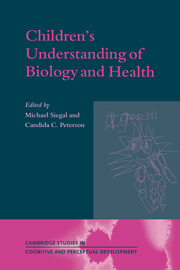Book contents
- Frontmatter
- Contents
- List of contributors
- Preface
- 1 Becoming mindful of biology and health: an introduction
- Part I Development of biological understanding
- Part II Health issues
- 5 What young children's understanding of contamination and contagion tells us about their concepts of illness
- 6 Children and pain
- 7 Children and food
- 8 The ethics of emaciation: moral connotations of body, self, and diet
- Part III Applications
- Appendix: Hypothetical dilemma vignettes
- Author index
- Subject index
7 - Children and food
Published online by Cambridge University Press: 06 July 2010
- Frontmatter
- Contents
- List of contributors
- Preface
- 1 Becoming mindful of biology and health: an introduction
- Part I Development of biological understanding
- Part II Health issues
- 5 What young children's understanding of contamination and contagion tells us about their concepts of illness
- 6 Children and pain
- 7 Children and food
- 8 The ethics of emaciation: moral connotations of body, self, and diet
- Part III Applications
- Appendix: Hypothetical dilemma vignettes
- Author index
- Subject index
Summary
As young omnivores, children need to learn an enormous amount about food and eating. Fortunately, eating occurs frequently each day, providing many opportunities for learning to occur. From birth to 5 years, food intake patterns change dramatically, and change occurs in food selection as well as in the number and timing of meals. For example, during the first weeks of life, it is not uncommon for an infant to consume ten meals in a twenty-four-hour period. By the preschool period, children are consuming three regularly scheduled meals each day. The reduction in the number of meals reflects a shift from depletion-driven eating to eating meals on a culturally acceptable schedule. Regarding what is eaten, infants of all cultures begin life consuming an exclusive milk diet. During the second half of the first year of life, dramatic dietary changes occur as infants make the transition from consuming a single food to selecting foods that compose a modified adult diet. At weaning, the diets of children from different cultural groups begin to diverge, so that by the age of 4 or 5, children of different cultural groups may be consuming diets that share no foods in common.
To investigate how children's food acceptance patterns develop during these first years of life, multiple disciplinary perspectives must be adopted; cultural, social, psychological, and physiological factors all affect the developing child's food selection and the timing and size of meals.
- Type
- Chapter
- Information
- Children's Understanding of Biology and Health , pp. 161 - 182Publisher: Cambridge University PressPrint publication year: 1999
- 11
- Cited by



